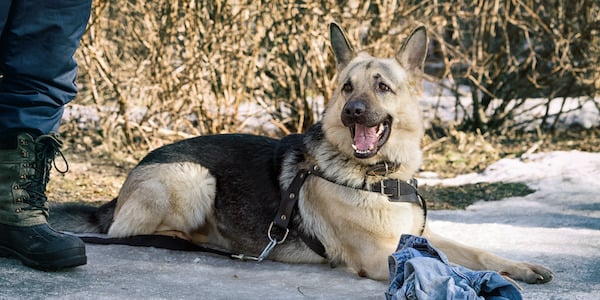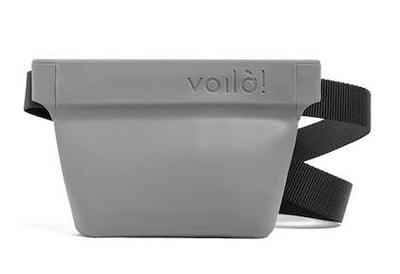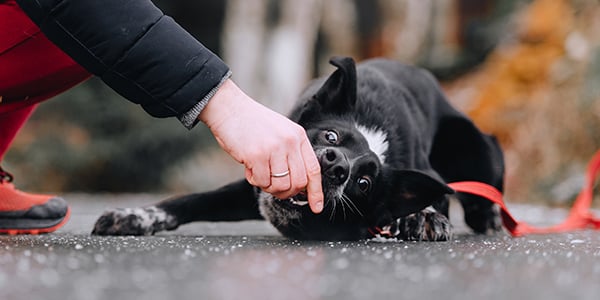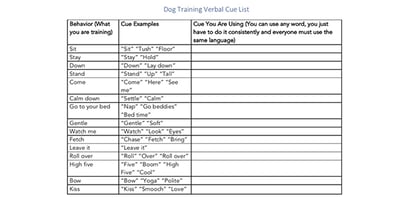 Teaching your dog to lie down when asked is an important training skill — it's one of the six things you should teach your dog to keep them safe. Not only is it useful in preventing unwanted behaviors such as door dashing, but it's also a great way to increase calm, settled behavior from your dog.
Teaching your dog to lie down when asked is an important training skill — it's one of the six things you should teach your dog to keep them safe. Not only is it useful in preventing unwanted behaviors such as door dashing, but it's also a great way to increase calm, settled behavior from your dog.
With a trained down cue, you can more easily enjoy sitting outside a coffee shop with your dog while they're settled next to you. Down is also helpful when teaching your dog other behaviors and tricks, such as go to bed or rollover.
Training "Down" Is Different Than Teaching Your Dog "Off"
One common misuse of the word "down" that I hear when working with training clients is it being used interchangeably with the "off" cue. Clarity is essential when teaching our dogs verbal cues. Don't expect your dog to understand exactly what you mean if the word you use isn't consistent.
When you ask your dog to lie down, it should mean they move into the down position. Saying "off" for most dog owners means getting off a piece of furniture, stopping counter surfing, or stopping jumping, and is a different action than lying down. Whatever word you use for a cue, try to keep it as clear and consistent as possible so your dog can learn faster. That way, your dog can better meet your training expectations!

PRO TIP: When it comes to dog training, it's important to have everyone in your home using the same cues. Download and customize this cue template and put it in a high-traffic area so everyone, including your dog walker or pet sitter, is on the same page.
How to Train Your Dog to Lie Down
What You'll Need:
 A training treat pouch. My favorite and the one I use the most is the Voilà Ultimate Treat Pouch. It's high-grade silicone, which makes it easy to wash and perfect for the fresh high-value dog treats I use the most. Use code PV10 to get 10% off!
A training treat pouch. My favorite and the one I use the most is the Voilà Ultimate Treat Pouch. It's high-grade silicone, which makes it easy to wash and perfect for the fresh high-value dog treats I use the most. Use code PV10 to get 10% off!- Your clicker (or marker word like "yes!" if you're not using a clicker)
- Your dog's favorite training treats (like these Zuke's Mini Naturals training treats, or low-fat string cheese, or turkey hotdogs cut up into tiny pieces.
Teaching Your Dog to Lie Down on Cue
The lure method is often the easiest for most dog owners to start with. A lure uses something your dog wants, like a treat or a toy, to guide them into the desired position. The motion you make when guiding your dog into a down will become smaller with practice and eventually become the hand signal for your dog's down. For most dog owners, this hand signal ends up being a point or flat palm down towards the ground. The goal is to fade out a lure and fade out food treats in your dog's training.
FAQ: Should You Start Teaching Down With Your Dog in a Sit or a Stand Position?
I like to practice both ways! By doing both, your dog won't get confused if you ask for a down when they aren't already sitting. It's also a great way to practice body awareness for your dog, as moving into a down from a stand is a different motion than lying down from a sit. It's also helpful to practice down from a stand position if you want to teach your dog the emergency down behavior (also called an emergency stop or safety stay).
For dogs that already know how to sit, it's often easiest to start there. If your dog is in the process of learning to sit, you can begin from a stand position. Mix it up as you practice.
Luring a Dog Into a Down Position (from a Sit Position)
When practicing these steps, your dog should already be sitting. You can lure them into the sit or give them a verbal cue to sit if you've previously trained this behavior. Check out our article, 2 Easy Ways to Teach Your Dog to Sit for instructions and training tips.
Step One: Hold a small training treat in your hand (or between your fingers if you're working with a smaller dog).Step Two: Place the hand with the treat very close to your dog's nose so they can smell you've got something yummy!
Step Three: Slowly move your hand from your dog's nose straight down to the floor, and then drag it slightly outwards and away from their nose. Think of this movement as if you were drawing the letter "L." Your dog will most likely follow the hand with their nose — they'll lower their head and shoulders down, and then as you drag the treat outwards, they should drop their elbows to the floor.
Step Four: Once their elbows hit the floor, click and give them the treat while they're in the down position!
Step Five: Repeat!
Step Six: With practice, your dog will anticipate what you're asking for when you start to move the lure. When you notice your dog's downs happening more quickly and not needing the full lure, it's time to move on to adding the verbal cue and fading out the hand lure.
Watch this video to see what luring your dog into a down from a sit looks like:
Luring a Dog Into a Down Position (from a Standing Position)
When practicing these steps, your dog should be standing.
Step One: Hold a small training treat in your hand (or between your fingers if you're working with a smaller dog).Step Two: Place the hand with the treat very close to your dog's nose so they can smell you've got something yummy!
Step Three: Slowly move your hand from your dog's nose down to the floor and slightly towards them. Think of this as drawing a diagonal line between their nose to in between their front paws. Your dog will most likely follow the hand with their nose, bending their elbows as their nose gets closer to the ground. Keep your hand lure still and wait until they drop their backend to the floor as well.
Step Four: Once their rear hits the floor, click and give them the treat while they're in the down position!
Step Five: Repeat!
Step Six: When you notice your dog's downs happening more quickly and not needing the full lure, it's time to move on to adding the verbal cue and fading out the hand lure.
Watch this video to see what luring your dog into a down from a stand looks like:
Adding a Verbal Cue for Down
Step One: First, make sure your dog is "getting" the down behavior with just the hand lure. If not, practice this more before adding the verbal cue.Step Two: Before you use the lure movement, say "down." Lure your dog into their down position, then click and treat as you have been doing.
Step Three: Repeat! With repetition, your dog is making the association of the word "down" with the action of lying down. You're naming the behavior for your dog.
Fading Out the Hand Lure for Down
Do a little down "quiz" with your dog. There's no wrong answer here! It's just to get an idea if your pup has made the association between the word and the action. Stand completely still with no lure or hand signal in front of your dog. Say "down" just once. Your dog will either:
Lie Down: If they lie down, click, and treat. Give them lots of praise!Not lie down: If they don't move into the down position, that's okay! Try giving them a smaller version of the lure to encourage them to lie down. Go back to adding the verbal cue step for more practice before quizzing again.
PRO TIP: While fading out the hand lure, consider how small you can make your lure movement for your dog to respond. For the down cue, I often only need to bend forward slightly with my shoulders. This slight motion is enough for many dogs to anticipate that I'm about to ask for a down, and they lie down to get a treat.
Why? Our dogs are incredibly keen when it comes to reading our human body language. Before we point towards the floor or otherwise move our hand and arm in the down lure, we almost always bend forward slightly. They've learned the sequence of the lure and know what's coming!

Practice Your Dog's Down in Different Places
Once your dog responds to the verbal cue to lie down, it's time to take your practice to the next level! Try asking your dog to lie down in different rooms of your home, outside in the yard, or while on a walk. Practice asking for a down while standing in front of them, beside them, or behind them. This is called the generalization of a training cue.
When I first work a cue in a new place or from a new position, I always set the dog up for success and take it back a few steps. If I'm practicing down in the backyard for the first time, I do a few repetitions using a lure before asking with just a verbal cue.
Keep using treats as a reward for your pup while adding distractions to your training. It can be hard for your dog to concentrate when there's lots of activity, like a squirrel or another dog. Treats are usually the easiest way to get and keep their attention.
PRO TIP: If your dog doesn't lie down when asked because they are too distracted, simply add distance between you and the distraction before trying again. Your other option is to increase the value of the treat reward (or consider using toys and play as a reward if your dog finds that more motivating).
Start to Fade Out Training Treats
While you continue practicing your dog's down, you can begin to phase out the use of training treats. I love using real-life rewards for a dog that lies down when asked. Sometimes I'll practice when playing fetch or tug, rewarding the down with another throw of the toy or engaging in more tug.
Read my article, Be a Slot Machine: How to Fade Out Food Treats in Dog Training to learn more about dog training without treats.
Want to add in stay to your dog's down? It's easy! And it's a good next phase of training for lie down, as you don't want them jumping right back up again. Staying in place is important, especially in emergency situations. Find out how to train this in How to Teach Your Dog to Stay.
Troubleshooting a Lured Down
What if your dog only follows the lure halfway but won't lie all the way down? Some dog body types make the traditional lure movement uncomfortable for them to follow. In my own experience, I've had to change my luring motion to better accommodate breeds like Greyhounds. I might guide them with the lure, so they're lying down in a more curved position to lessen pressure on their chest from the floor. For short-legged breeds, such as Corgis or Dachshunds, I tend to rely on the capturing training method (explained below) or speed up my lure movement to encourage the change in position. Play around with your lure movement and speed to see what might entice your dog to settle into the down position.
What if my dog just won't lie down following a lure? You can always start with the capturing method explained below, but you can also use your leg, table, or chair to help your dog move into the right position. Watch this video from Kikopup to see how:
What if your dog isn't interested in the lure? Consider if you're using a treat that's motivating enough for your dog. You can change to a higher value training treat, or try again when they might be more hungry. I often will switch to the capturing technique explained below if I'm working with a dog that's not interested in lures.
Capturing Your Dog's Down Behavior
Capturing a behavior is different from luring as we're not guiding our dog into position with our hand. We actually don't have to do anything other than pay attention to what our dog is doing and be patient! Capturing is like taking a picture of the behavior with our clicker, then treating it. Your dog will learn that lying down makes you click and choose to keep doing it to get a click and a treat.
Step One: Have your clicker and treats ready.PRO TIP: If you want to use the capturing method to train your dog, it's helpful to have already introduced them to clicker training or their marker word. Read about how to "charge" a clicker or marker word to make it mean something to your dog in our article An Introduction to Clicker Training.
Step Two: Whenever your dog lies down on their own, with no prompting from you, click!
Step Three: Remember, every click gets a treat! I like to place the treat reward on the ground between the dog's paws when they lie down first, then toss another treat a few steps away from the dog. This helps build up a longer down-stay duration, and then resets them so they can offer another down!
Step Four: Repeat!
Watch this short video clip from Lucky Dog Sports Club showing capturing a down in action:
Once your pup has that lightbulb moment and begins offering a down to make you click, it's time to add in the verbal cue. Following the same steps as outlined above in the lure method, simply say the word "down" as your dog is lying down, click, and treat. You can then move on to practicing in different environments and begin phasing out your clicker and training treats.
Troubleshooting a Captured Down
What if my dog never offers a down for me to reward? If your dog doesn't seem to want to lie down when you're hoping to capture it, there might be a few reasons:
- Is the area you're in comfortable for your dog to lie down? Consider practicing near to their bed or other softer place, like a carpeted room or near a rug, where they might be more inclined to lie down.
- Are they too excited and have lots of energy? Lying down is a more settled behavior — practice later in the evening when your dog might be more relaxed and calm, or after a long walk or sniffari adventure when they're more physically tired.

Be Aware of Any Pain or Discomfort When Asking Your Dog to Lie Down
Always consider if the action of lying down is uncomfortable or painful for your dog. Their pain could be due to injury, obesity, arthritis, or another medical condition. If your dog has a painful condition or injury, don't ask them to lie down. If your dog is moving into their down slowly, is stiff in their movement to lie down or get up, or hesitates when you ask them to lie down, visit your veterinarian to find out if they are in pain. Your veterinarian can help you begin a treatment or pain management plan.
Dogs are experts at hiding pain — if you aren't sure whether your dog might be hurting, learn more about what signs to look for in How Can I Tell If My Dog Is In Pain?
PRO TIP: If your dog is hesitant to sit or lie down, it could be due to impacted or infected anal glands — especially if they had done these things easily before, but are suddenly less inclined to do so. Read more in our article Anal Glands — Why Dogs Have Them & What To Do When They're a Problem.
Now that your dog is on their way to learning the down cue, think about all the ways you can use it out and about. I use this the most when I want to sit outside a coffee shop on a nice day. I bring along a portable dog mat like this RUFFWEAR Highlands Portable Dog Mat (or even just a rubber-backed bath mat works!) and have my dog lie down next to me. I also do this when we're at our veterinary clinic waiting in the lobby for our appointments. Being in a settled down position on a comfortable spot means my dog isn't barking or pulling towards other dogs she sees.
I also love to use down as part of what I call "puppy push-ups" — asking a dog to sit, down, sit, and stand in quick succession. This game is excellent training practice, builds body awareness, and helps burn crazy puppy energy and increase focus.
When do you use your dog's down cue the most? Let us know in the comments!




